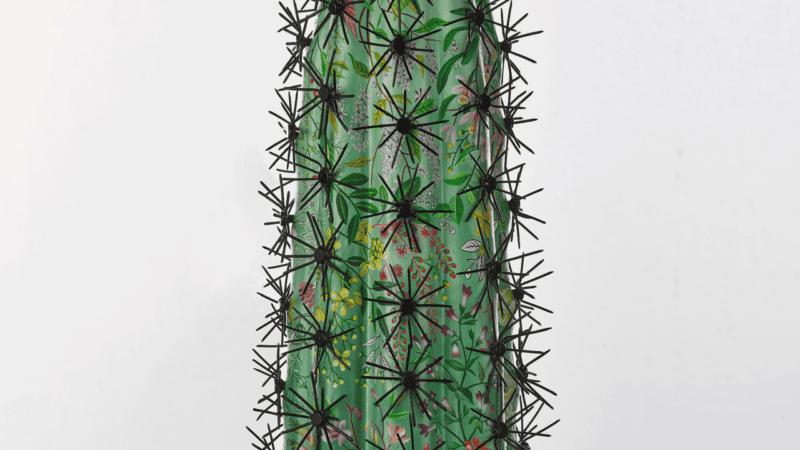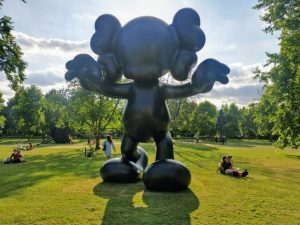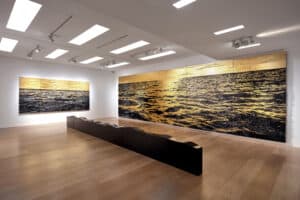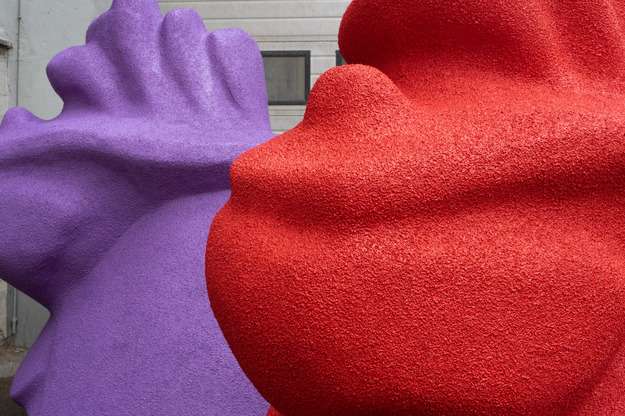
Lena Henke R.M.M. (Power Broker Purple), 2020 Steel, fiberglass, rubber, paint 78 3/4 x 67 x 70 7/8 in.
Frieze and Tishman Speyer have announced a special exhibition of site-specific works by six renowned artists, which will comprise the second year of Frieze Sculpture at Rockefeller Center. Usually held in the spring as part of the wider programming of Frieze New York, Frieze Sculpture at Rockefeller Center was postponed and readapted this year due to the COVID-19 pandemic. Presented in partnership with Tishman Speyer, the major public art initiative places significant sculptural works by leading artists in open, public locations throughout Rockefeller Plaza, allowing for ample social distancing space in compliance with all City and State guidelines. Offering free admission to all, Frieze Sculpture at Rockefeller Center will be on display from September 1 – October 2, 2020.
‘So much has changed since our planned opening of this year’s Frieze Sculpture on the 50th Anniversary of Earth Day, April 22nd’
said Loring Randolph, Director of Frieze New York,
‘but what has not waivered is Frieze and Rockefeller Center’s commitment to putting the art of our time in the public realm. I am particularly excited to have the opportunity to see Ghada Amer’s Women’s Qualities take over the Channel Gardens, and self-taught 94-year old artist, Thaddeus Mosely, showcase his first bronze sculptures at the apex of those gardens on 5th Avenue.’
Curated by Brett Littman (Director of the Isamu Noguchi Foundation and Garden Museum in Long Island City, New York), the second edition is inspired by the site’s and the city’s natural materials of earth, rock, and plants, and by the 50th anniversary of Earth Day, the original date when Frieze Sculpture at Rockefeller Center was scheduled to debut. Artists Ghada Amer, Beatriz Cortez, Andy Goldsworthy, Lena Henke, Camille Henrot and Thaddeus Mosley have responded to that inspiration, with Amer, Cortez, Goldsworthy, Henke, and Mosley creating major new site-specific works.
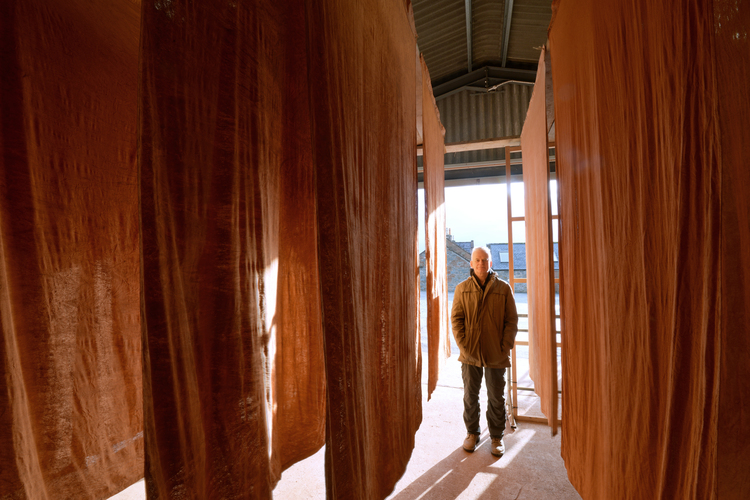
Andy Goldsworthy with Red Flags, 2020 (in progress).© Andy Goldsworthy Courtesy Galerie Lelong & Co., New York
‘The projects for this year’s Frieze Sculpture deal with a range of issues including women’s suffrage, migration, urban planning, and ecology. They are also grounded in the celebration of the natural and botanical worlds, and in some cases the artists use plants and flowers as part of their sculptures. Given our world’s current urgent concerns with ecological sustainability, climate change and racial inequality – and the impact these issues have had in spreading COVID-19 – the idea of creating an outdoor sculpture installation within this discourse, could not be more relevant.’
Brett Littman
The Frieze Sculpture at Rockefeller Center program includes:
Ghada Amer (Goodman Gallery, Marianne Boesky): Egypt-born New York-based artist Ghada Amer presents an ambitious garden installation, titled Women’s Qualities. The piece was first conceptualised and installed in Busan, South Korea, in 2000 after the artist undertook a simple study, asking members of the public what qualities they found most important in women. 20 years on, the artist revisits the piece in New York, combining gender stereotypes that she encountered in Busan in 2000 with perspectives from Americans in 2020. The responses are written with flowers to create a living portrait of the impossible “woman ideal”.
Beatriz Cortez (Commonwealth and Council): Awarded the inaugural Frieze LIFEWTR Sculpture Prize, Cortez will present a new commission selected for inclusion by a jury chaired by Brooke Kamin Rapaport (Deputy Director and Martin Friedman Chief Curator, Madison Square Park Conservancy), and guest judges Taylor Aldridge, Brett Littman, Loring Randolph, and Michaella Solar-March. Made of steel frame and sheet metal, Glacial Erratic evokes an ancient boulder, like the numerous glacial erratics that populate the landscape in New York City. Placed in the context of Rockefeller Center, the sculpture will age as it is exposed to the elements and human traffic while marking different temporalities and making visible the planetary nature of ancient migration.
Andy Goldsworthy (Galerie Lelong & Co.): Red Flags (2020) is a major new installation looking at the contexts of flags – their inherent and potential meanings – in one of New York’s most iconic flag flying sites. Goldsworthy replaces Rockefeller Center’s flags with flags colored with earth gathered from each of the 50 states.
Lena Henke (Bortolami): Two new sculptures, R.M.M. (Power Broker Purple) (2020) and R.M.M. (Organ, Organ, Organ Red) (2020) combine Henke’s personal experience and the history of New York City’s urban planning, in particular the controversial designs of architect Robert Moses (1888-1961). The sheer size of these new works was based on Henke’s own height, and determined with the help of Le Corbusier’s, Modular, and anthropometric scale of proportions, placing her own body in direct relation to Rockefeller Center’s canonical architectural space. In their new context, set in front of the main entrance at Rockefeller Center’s formal Art Deco-influenced complex, the large, colorful hooves become objects of irrational, organic flux. They are an ode to the many equestrian symbols in and outside of Rockefeller Center’s buildings, the horse motifs In Carl Milles’ three-part work Man and Nature (1937-41); Attilio Piccirilli’s glass block panel Youth Leading Industry (1936), installed over the Fifth Avenue entrance at the International Building North; and Robert Garrison’s fantastical stone bas-relief, Morning, Present, Evening (1932) including the head of the mythological horse at the 1270 entrance.
Camille Henrot (Metro Pictures): Inside Job is a bronze sculpture to be installed in Rockefeller Center’s Channel Gardens. Evoking both the shape of a shark and also the beak of a bird, the work explores concurrent themes of threat and tenderness. Henrot will also present a series of small-scale works from Is it possible to be a revolutionary and like flowers? taking inspiration from previous collaborations with artists undertaken at the S?getsu School. The title of each piece is taken from a book, creating a library of literature translated into flowers.
Thaddeus Mosley (Karma): Three monumental freestanding sculptural editions, all specifically fabricated for Frieze Sculpture, entitled Illusory Progression, True to Myth, and Rhizogenic Rhythms have been sited on 5th Avenue in front of the Channel Gardens. These bronze works are the first multiple cast works in Mosley’s 60-year career and are based on his unique sculptures with salvaged Pittsburgh timber and discarded wood fragments and demonstrates what he describes as ‘weight in space.’
Brett Littman is the Director of the Isamu Noguchi Foundation and Garden Museum in Long Island City, New York. He was the Executive Director of The Drawing Center from 2007-2018; the Deputy Director of MOMA PS1 from 2003-2007; the Co-Director of Dieu Donné Papermill from 2001-2003 and the Associate Director of UrbanGlass from 1996-2001. His interests are multi-disciplinary. He has curated more than twenty-five and overseen more than seventy-five exhibitions over the last decade dealing with visual art, self-taught art, craft, design, architecture, poetry, music, science, and literature. Littman is also an art critic and lecturer, an active essayist for museum and gallery catalogs and has written articles for a wide range of United States-based and international art, fashion, and design magazines.
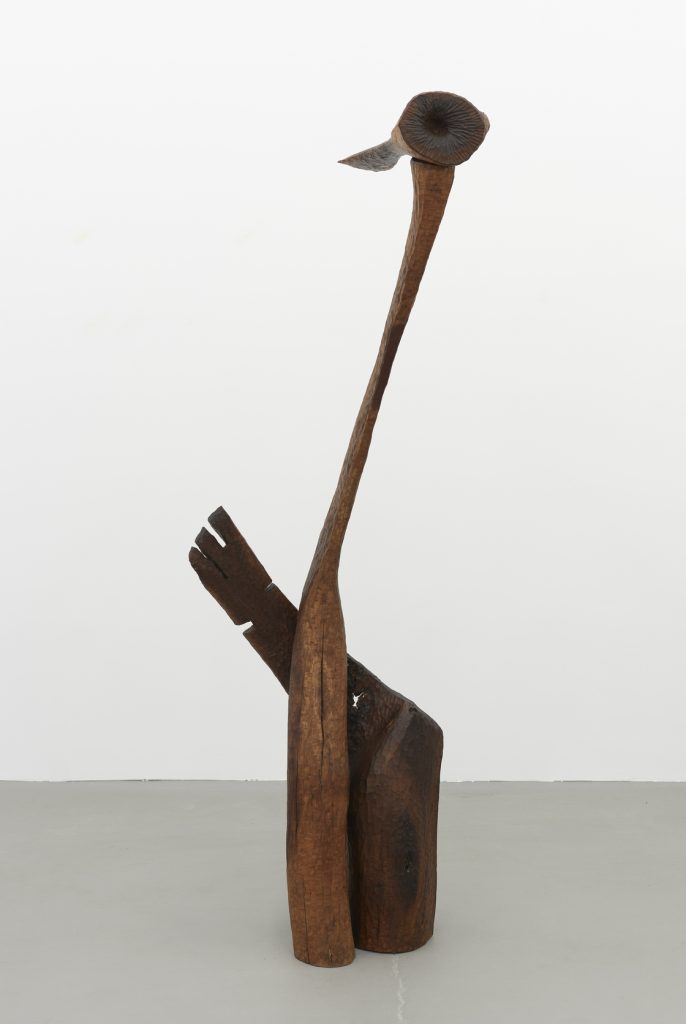
Thaddeus Mosley?Rhizogenic Rhythms, 2005?Walnut, cherry?84 x 36 x 30 in; 213 x 91 x 76 cm
Second Edition of Frieze Sculpture at Rockefeller Center® Presents Works from Leading International Artists Ghada Amer, Beatriz Cortez, Andy Goldsworthy, Lena Henke, Camille Henrot and Thaddeus Mosley
Frieze Sculpture at Rockefeller Center will be on display from September 1 – October 2, 2020
Free admission for all.#FriezeSculpture
About the Artists
Ghada Amer was born in Cairo in 1963 and raised in France where she studied at Villa Arson, Nice. She currently lives and works in New York. Her wide-ranging practice spans painting, sculpture, works on paper, and garden and mixed-media installations. Over the course of her multi-decade career, Amer has created an aesthetic and conceptual language that confronts the systemic subjugation of the female voice and body. Recognizing the ways in which women are taught, almost from birth, to model behaviors and traits shaped by others, Amer’s work actively subverts these frameworks, creating a space that recognizes and celebrates female autonomy, sexuality, and liberation. “I believe that all women should like their bodies and use them as tools of seduction,” Amer stated. Together, her paintings, sculptures, and garden projects explore the complicated nature of identity, developed throughout cultural and religious norms as well as personal longings and understandings of the self. Amer’s works have been exhibited at institutions including the Museum of Modern Art in New York, the Whitney Biennial, the Venice Biennale, the Brooklyn Museum, the Smithsonian National Museum of African Art In Washington, DC, the Centre Georges Pompidou in Paris, the Garage Center for Contemporary Culture in Moscow, among others. Her works can be found in the collections of the Art Institute of Chicago, the Brooklyn Museum, the entre Georges Pompidou, the Museo Jumex in Mexico City, the Crystal Bridges Museum of Art in Arkansas, the Guggenheim Abu Dhabi, the Museum of Arts and Design in New York, and the Leeum, Samsung Museum in Seoul, among others.
Beatriz Cortez (b. 1970, San Salvador, El Salvador) is a multidisciplinary artist based in Los Angeles. Her work explores simultaneity, life in different temporalities and versions of modernity, memory and loss in the aftermath of war and the experience of migration, and in relation to imaging possible futures. Her work has been shown recently in the following exhibitions: ‘In Plain Sight’, Henry Art Gallery, Seattle; ‘Candelilla, Coatlicue, and the Breathing Machine’, Ballroom Marfa, Texas; ‘Unfolding Universes’, Museo de Arte Moderno de Bogotá, Colombia; ‘Utopian Imagination’, Ford Foundation Gallery, New York; ‘Paroxysm of Sublime’, Los Angeles Contemporary Exhibitions, Los Angeles; ‘Ingestion, TEORé/Tica’, San José, Costa Rica; ‘Mundos Alternos: Art and Science Fiction in the Americas’, Queens Museum, New York; and ‘Chronos, Cosmos: Deep Time, Open Space’, Socrates Sculpture Park, New York. Cortez has received the Artadia Los Angeles Award (2020), Frieze LIFEWTR Inaugural Sculpture Prize (2019), Rema Hort Mann Foundation Emerging Artist Grant (2018), and California Community Foundation Fellowship for Visual Artists (2016), among others. She holds an MFA from the California Institute of the Arts, and a doctorate in Latin American Literature from Arizona State University. She teaches at California State University, Northridge. Beatriz Cortez is represented by Commonwealth and Council, Los Angeles.
Andy Goldsworthy: In a diverse career spanning five decades, Andy Goldsworthy has become one of the most prominent and iconic contemporary sculptors. In photographs, sculptures, installations, and films, Goldsworthy documents his exploration of effects of time, the relationship between humans and their natural surroundings, and the beauty in loss and regeneration. Goldsworthy’s permanent projects and ephemeral works contrast in their scale, tension, and lifetime, but are unified through their responses to the environment and his constant investigation into understanding the landscape he is in. Recent permanent site-specific installations by Goldsworthy include Walking Wall, The Nelson-Atkins Museum of Art, Missouri; Hanging Stones, Rosedale, North York Moors, UK; Watershed, deCordova Sculpture Park and Museum, Massachusetts; Arundel Street, London, UK; Stone Sea, Saint Louis Art Museum, Missouri; and Chaumont Cairn, Domaine de Chaumont-sur-Loire, France. Other permanent works can be seen at the National Gallery of Art, Washington, D.C.; de Young Museum, California; Museum of Jewish Heritage, New York; Albright Knox Art Gallery, New York; Storm King Art Center, New York; Stanford University, California; Haute Provence Geological Reserve in Digne-les-Bains, France; and The Presidio of San Francisco, California, among numerous other sites. Major solo exhibitions of Goldsworthy’s work have been presented by the Yorkshire Sculpture Park, England; Museo Nacional Centro de Arte Reina Sofía, Spain; Metropolitan Museum of Art, New York; Neuberger Museum of Art, New York; Museum of Contemporary Art San Diego, California; and Des Moines Art Center, Illinois. The artist was born in Cheshire, England, in 1958, and is now based in Scotland.
Lena Henke (b. 1982 in Warburg, Germany). Henke’s work addresses urban planning, Land Art, human relationships, sexuality and fetishism, consistently infiltrating the patriarchal structure of art history with a smart and humorous tone. Her formal language and use of materials often alludes to Minimal Art combined vividly with Surrealist imagery to examine the structures of street life and the ideas of city planners and urban theorists such as Jane Jacobs, Roberto Burle Marx, and Robert Moses. Lena Henke lives and works in New York and Berlin. Henke has been the subject of solo exhibitions at Museum für Gegenwartskunst Siegen (accompanied by a comprehensive publication), Kunsthalle Zurich, Schirn Kunsthalle, Kunstverein Braunschweig, and White Flag projects. Her work has also been shown in numerous institutions including the Whitney Museum of American Art, Kunstmuseum Luzern, Kunsthalle Bern, Hessel Museum of Art, the Sprengel Museum in Hannover, and MoCA Detroit. Her work has been featured in major international exhibitions including the Timisoara Contemporary Art Biennale, Romania, (2017); Manifesta 11, Zurich, Switzerland (2016); The 9th; Berlin Biennale, Germany (2016); Le Biennale de MONTREAL, Montreal, Canada, (2016); at the Triennale of Small Scale Sculpture in Fellbach, Germany (2016); and The New Museums Triennial, New Museum, New York (2015). Henke’s work is in collections of ICA Miami, the Whitney Museum of American Art, The Hessel Museum of Art, MKG Siegen, MAMCO Geneva, Kunsthalle Bern, and Kunsthalle Bielefeld among others.
Camille Henrot was born in 1978 in Paris and lives and works in New York. A survey exhibition at the National Gallery of Victoria, Melbourne is scheduled for 2021. Additional one person exhibitions are scheduled at Art Sonje, Seoul (2020); Kestnergesellchaft, Hannover (2020); and the Middelheim Museum in Antwerp (2022). Her work will be included in the 2020 editions of the Liverpool Biennial and the Busan Biennale. In 2017 her “Carte Blanche” exhibitions ‘Days are Dogs’ opened at Palais de Tokyo in Paris. She presented ‘The Pale Fox’ at Chisenhale Gallery, London, in 2014, which later travelled to Béton salon, Paris; Kunsthal Charlottenborg, Copenhagen; and Westfalen Kunstverein Münster. She has had additional one-person exhibitions at Tokyo Opera City Art Gallery, Kunsthalle Wien; Albright-Knox Art Gallery, Buffalo; La Fondazione Memmo, Rome; New Museum, New York; Schinkel Pavillon, Berlin; New Orleans Museum of Art; Espace Culturel Louis Vuitton, Paris; and Jeu de Paume, Paris. She participated in the 9th Berlin Biennale; Prospect 3, New Orleans; and the 2014 Taipei and Gwangju Biennials. Her awards include the Silver Lion at the 55th Venice Biennale, the 2014 Nam Jun Paik Award, and the 2015 Edvard Munch Award, which will be accompanied by a one-person exhibition at the Munch Museum in Oslo in 2021.
Thaddeus Mosley (b. 1926) is a Pittsburgh-based self-taught artist whose monumental sculptures are crafted with the felled trees of Pittsburgh’s urban canopy, via the city’s Forestry Division; wood from local sawmills; and reclaimed building materials. Using only a mallet and chisel, he reworks salvaged timber into biomorphic forms. With influences ranging from Isamu Noguchi to Constantin Brâncu?i – and the Bamum, Dogon, Baoulé, Senufo, Dan, and Mossi works of his personal collection – Mosley’s sculptures mark an inflection point in the history of American abstraction. These “sculptural improvisations,” as he calls them, take cues from the modernist traditions of jazz. “The only way you can really achieve something is if you’re not working so much from a pattern,” Mosley says of his improvisational method. “That’s also the essence of good jazz.” Mosley’s work has been exhibited and acquired by major museums and foundations since 1959, including the Mattress Factory Museum, Pittsburgh, and most recently, the Carnegie Museum of Art, for the occasion of the 57th Edition Carnegie International (2018).

